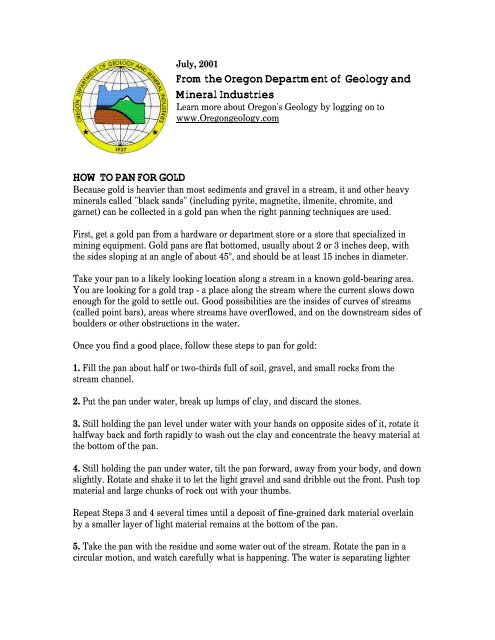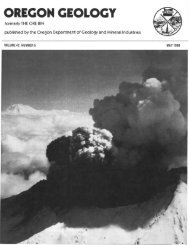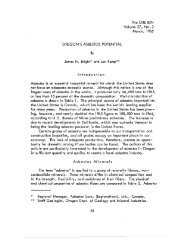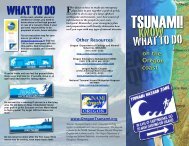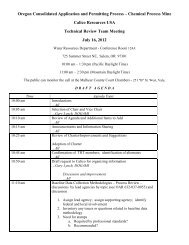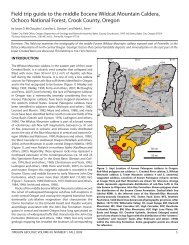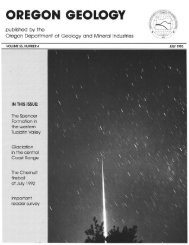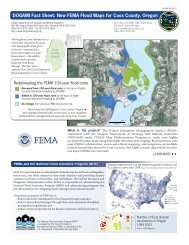How (and where) to pan for gold - Oregon Department of Geology ...
How (and where) to pan for gold - Oregon Department of Geology ...
How (and where) to pan for gold - Oregon Department of Geology ...
You also want an ePaper? Increase the reach of your titles
YUMPU automatically turns print PDFs into web optimized ePapers that Google loves.
July, 2001<br />
From the <strong>Oregon</strong> <strong>Department</strong> <strong>of</strong> <strong>Geology</strong> <strong>and</strong><br />
Mineral Industries<br />
Learn more about <strong>Oregon</strong>'s <strong>Geology</strong> by logging on <strong>to</strong><br />
www.<strong>Oregon</strong>geology.com<br />
HOW TO PAN FOR GOLD<br />
Because <strong>gold</strong> is heavier than most sediments <strong>and</strong> gravel in a stream, it <strong>and</strong> other heavy<br />
minerals called "black s<strong>and</strong>s" (including pyrite, magnetite, ilmenite, chromite, <strong>and</strong><br />
garnet) can be collected in a <strong>gold</strong> <strong>pan</strong> when the right <strong>pan</strong>ning techniques are used.<br />
First, get a <strong>gold</strong> <strong>pan</strong> from a hardware or department s<strong>to</strong>re or a s<strong>to</strong>re that specialized in<br />
mining equipment. Gold <strong>pan</strong>s are flat bot<strong>to</strong>med, usually about 2 or 3 inches deep, with<br />
the sides sloping at an angle <strong>of</strong> about 45º, <strong>and</strong> should be at least 15 inches in diameter.<br />
Take your <strong>pan</strong> <strong>to</strong> a likely looking location along a stream in a known <strong>gold</strong>-bearing area.<br />
You are looking <strong>for</strong> a <strong>gold</strong> trap - a place along the stream <strong>where</strong> the current slows down<br />
enough <strong>for</strong> the <strong>gold</strong> <strong>to</strong> settle out. Good possibilities are the insides <strong>of</strong> curves <strong>of</strong> streams<br />
(called point bars), areas <strong>where</strong> streams have overflowed, <strong>and</strong> on the downstream sides <strong>of</strong><br />
boulders or other obstructions in the water.<br />
Once you find a good place, follow these steps <strong>to</strong> <strong>pan</strong> <strong>for</strong> <strong>gold</strong>:<br />
1. Fill the <strong>pan</strong> about half or two-thirds full <strong>of</strong> soil, gravel, <strong>and</strong> small rocks from the<br />
stream channel.<br />
2. Put the <strong>pan</strong> under water, break up lumps <strong>of</strong> clay, <strong>and</strong> discard the s<strong>to</strong>nes.<br />
3. Still holding the <strong>pan</strong> level under water with your h<strong>and</strong>s on opposite sides <strong>of</strong> it, rotate it<br />
halfway back <strong>and</strong> <strong>for</strong>th rapidly <strong>to</strong> wash out the clay <strong>and</strong> concentrate the heavy material at<br />
the bot<strong>to</strong>m <strong>of</strong> the <strong>pan</strong>.<br />
4. Still holding the <strong>pan</strong> under water, tilt the <strong>pan</strong> <strong>for</strong>ward, away from your body, <strong>and</strong> down<br />
slightly. Rotate <strong>and</strong> shake it <strong>to</strong> let the light gravel <strong>and</strong> s<strong>and</strong> dribble out the front. Push <strong>to</strong>p<br />
material <strong>and</strong> large chunks <strong>of</strong> rock out with your thumbs.<br />
Repeat Steps 3 <strong>and</strong> 4 several times until a deposit <strong>of</strong> fine-grained dark material overlain<br />
by a smaller layer <strong>of</strong> light material remains at the bot<strong>to</strong>m <strong>of</strong> the <strong>pan</strong>.<br />
5. Take the <strong>pan</strong> with the residue <strong>and</strong> some water out <strong>of</strong> the stream. Rotate the <strong>pan</strong> in a<br />
circular motion, <strong>and</strong> watch carefully what is happening. The water is separating lighter
from heavier material-<strong>and</strong> <strong>gold</strong>, if it is present <strong>and</strong> you are doing the <strong>pan</strong>ning properly, is<br />
lagging behind the other material at the bot<strong>to</strong>m <strong>of</strong> the <strong>pan</strong>.<br />
6. S<strong>to</strong>p the rotation. If you are lucky, you will see a few flecks <strong>of</strong> <strong>gold</strong> in the dark<br />
material that remains in the bot<strong>to</strong>m <strong>of</strong> the <strong>pan</strong>. Carefully drain out water <strong>and</strong> let the black<br />
s<strong>and</strong> <strong>and</strong> <strong>gold</strong> dry. Lift out most <strong>of</strong> the black s<strong>and</strong> with a magnet, <strong>and</strong> separate that <strong>gold</strong><br />
from the remainder <strong>of</strong> the sediment with tweezers.<br />
WHERE TO PAN ON FEDERAL LAND<br />
In addition, <strong>gold</strong> <strong>pan</strong>ning is permitted on nearly all streams <strong>and</strong> rivers running through<br />
campgrounds on Bureau <strong>of</strong> L<strong>and</strong> Management (BLM) <strong>and</strong> USDA Forest Service (USFS)<br />
l<strong>and</strong> in <strong>Oregon</strong>.<br />
Maps showing locations <strong>of</strong> campgrounds may be obtained from local BLM <strong>and</strong> USFS<br />
<strong>of</strong>fices; from the Nature <strong>of</strong> the Northwest In<strong>for</strong>mation Center, 800 NE <strong>Oregon</strong> St. Suite<br />
177, Portl<strong>and</strong>, OR 97232, phone (503) 872-2750; or from the BLM <strong>Oregon</strong> State Office,<br />
PO Box 2965, 1515 SW First, Portl<strong>and</strong>, OR 97208, phone (503) 952-6002.<br />
ALL THAT GLITTERS IS NOT GOLD<br />
All the shiny <strong>gold</strong>-colored material in you <strong>gold</strong> <strong>pan</strong> may not be <strong>gold</strong>. Pyrite, known as<br />
"fools <strong>gold</strong>," has fooled many be<strong>for</strong>e you. On close examination, however, pyrite does<br />
not really look like <strong>gold</strong>. Pyrite has a brassy color, is sometimes tarnished, <strong>and</strong>, because it<br />
occurs as crystals, changes shades as you rotate it in the sun. Gold is always <strong>gold</strong> colored,<br />
s<strong>of</strong>t, <strong>and</strong> malleable or bendable.<br />
If you see <strong>gold</strong>-colored flecks that either float on the water or are so light in weight that<br />
they easily wash out <strong>of</strong> the <strong>pan</strong>, you probably have small pieces or "books" <strong>of</strong> mica, a<br />
mineral that because it is transparent <strong>and</strong> heat resistant was once used in doors <strong>of</strong> s<strong>to</strong>ves<br />
so the fire could be seen. Mica has a tendency <strong>to</strong> break apart in<strong>to</strong> flat sheets. It comes in<br />
several colors, <strong>and</strong> the the <strong>gold</strong>-colored variety is sometimes mistaken <strong>for</strong> <strong>gold</strong> by<br />
inexperiences <strong>gold</strong> <strong>pan</strong>ners.<br />
If you are lucky enough <strong>to</strong> find <strong>gold</strong> in your <strong>pan</strong>, it can come in many shapes: small<br />
lumps or nuggets, wires, feather-shaped crystals, or flat flecks. Pieces can range in size<br />
from almost microscopic "colors" (very small pieces) up <strong>to</strong> fist-sized nuggets, but your<br />
chances <strong>of</strong> finding the latter are pretty remote. <strong>How</strong>ever, <strong>gold</strong> <strong>pan</strong>ners are optimistic, <strong>and</strong><br />
you never know what the next <strong>pan</strong> will produce.<br />
PANNING ON STATE LANDS<br />
In <strong>Oregon</strong>, areas below the vegetation line on navigable rivers <strong>and</strong> streams <strong>and</strong> ocean<br />
beaches belong <strong>to</strong> the State <strong>of</strong> <strong>Oregon</strong> <strong>and</strong> are there<strong>for</strong>e open <strong>for</strong> recreational <strong>gold</strong><br />
<strong>pan</strong>ning.<br />
GOLD VIEWING
A large collection <strong>of</strong> <strong>gold</strong> is on display in the lobby <strong>of</strong> the Baker City Branch, US Bank,<br />
in Baker City in eastern <strong>Oregon</strong>. Included in the collection is the famous Armstrong<br />
nugget, weighing 80.4 ounces.<br />
WHERE TO PAN FOR GOLD IN OREGON<br />
To find <strong>gold</strong>, you should go <strong>where</strong> <strong>gold</strong> has been found be<strong>for</strong>ein northeast <strong>Oregon</strong>,<br />
southwest <strong>Oregon</strong>, <strong>and</strong> the Western Cascades. These areas have many streams <strong>and</strong> rivers<br />
that can be successfully <strong>pan</strong>ned <strong>for</strong> <strong>gold</strong>.<br />
FEDERAL LANDS<br />
Mining claims on Federal l<strong>and</strong> are not open <strong>for</strong> <strong>gold</strong> <strong>pan</strong>ning unless permission has been<br />
granted by the owner. <strong>How</strong>ever, four areas have been set aside on Federal l<strong>and</strong> in <strong>Oregon</strong><br />
<strong>for</strong> recreational <strong>gold</strong> <strong>pan</strong>ning:<br />
Area 1. Quartzville Recreational Corridor:<br />
Located in the Western Cascades, Salem District, Bureau <strong>of</strong> L<strong>and</strong> Management (free<br />
site). The Salem District Office address is 1717 Fabry Road SE, Salem, OR 97306, phone<br />
(503) 375-5646.<br />
Area 2. Butte Falls Recreational Area:<br />
Located in southwestern <strong>Oregon</strong>, Med<strong>for</strong>d District, Bureau <strong>of</strong> L<strong>and</strong> Management (free<br />
site). The Med<strong>for</strong>d address is 3040 Biddle Road, Med<strong>for</strong>d, OR 97504, phone (541) 770-<br />
2200.<br />
Area 3. Applegate Ranger District:<br />
Located in southwestern <strong>Oregon</strong>, Rogue River National Forest (four fee sites <strong>where</strong> there<br />
is a charge <strong>of</strong> a dollar a day <strong>for</strong> <strong>pan</strong>ning in areas adjacent <strong>to</strong> campgrounds). The<br />
Applegate Ranger District address is 6941 Upper Applegate Road, Jacksonville, OR<br />
97530, phone (541) 899-1812.<br />
Area 4. Wallowa-Whitman National Forest:<br />
Located in northeastern <strong>Oregon</strong> (free sites). Forest Supervisor is located at PO Box 907,<br />
Baker City, OR 97814, phone (541) 523-6391. Areas set aside <strong>for</strong> recreational <strong>gold</strong><br />
mining in the Wallowa-Whitman National Forest are listed below:<br />
a. Eagle Forks Campground, 9 mi northwest <strong>of</strong> Richl<strong>and</strong>, T. 8 S., R. 44 E., Pine Ranger<br />
District, Halfway, OR 97834, phone (541) 742-7511.<br />
b. McCully Forks Campground, on McCully Forks Creek just west <strong>of</strong> Sumpter, T. 9 S.,<br />
R. 36 E.; Deer Creek Campground, on Deer Creek north <strong>of</strong> Phillips Lake, T. 9 S., R. 38<br />
E.; <strong>and</strong> Powder River Recreational Area, on the Powder River just below Mason Dam, T.<br />
10 S., R. 39 E.; all located in the Baker Ranger District, Baker City, OR 97814, phone<br />
(541) 523-4476.
c. Antlers Guard Station, on the Burnt River, T. 11 S., R. 36 E., Unity Ranger District,<br />
Unity, OR 97884, phone (541) 446-3351.<br />
In addition, <strong>gold</strong> <strong>pan</strong>ning is permitted on nearly all streams <strong>and</strong> rivers running through<br />
campgrounds on Bureau <strong>of</strong> L<strong>and</strong> Management (BLM) <strong>and</strong> USDA Forest Service (USFS)<br />
l<strong>and</strong> in <strong>Oregon</strong>.<br />
Maps showing locations <strong>of</strong> campgrounds may be obtained from local BLM <strong>and</strong> USFS<br />
<strong>of</strong>fices; from the Nature <strong>of</strong> the Northwest In<strong>for</strong>mation Center, 800 NE <strong>Oregon</strong> St. #28,<br />
Suite 965, Portl<strong>and</strong>, OR 97232, phone (971) 673-2331; or from the BLM <strong>Oregon</strong> State<br />
Office, PO Box 2965, 1515 SW First, Portl<strong>and</strong>, OR 97208, phone (503) 952-6002.<br />
Learn more about <strong>Oregon</strong>'s <strong>Geology</strong> by logging on <strong>to</strong> www.<strong>Oregon</strong>geology.com<br />
The <strong>Oregon</strong> <strong>Department</strong> <strong>of</strong> <strong>Geology</strong> <strong>and</strong> Mineral Industries (DOGAMI) is headquartered in Portl<strong>and</strong> <strong>and</strong> is<br />
an independent agency <strong>of</strong> the State. It has a broad responsibility in developing a geologic <strong>and</strong> engineering<br />
underst<strong>and</strong>ing <strong>of</strong> natural hazards, then applying this in<strong>for</strong>mation <strong>to</strong> help mitigate the risks <strong>of</strong> earthquakes,<br />
l<strong>and</strong>slides, floods, <strong>and</strong> tsunamis. The <strong>Department</strong> is also the lead state regula<strong>to</strong>ry <strong>and</strong> reclamation agency<br />
<strong>for</strong> mining, oil, natural gas <strong>and</strong> geothermal exploration <strong>and</strong> production.<br />
For more in<strong>for</strong>mation on upcoming events <strong>and</strong> current projects, contact James Roddey at 800 NE <strong>Oregon</strong><br />
St., Portl<strong>and</strong>, OR 97232, (503) 731-4100, ext. 242 or DOGAMI field <strong>of</strong>fices at 1510 Campbell St., Baker<br />
City, (541) 523-3133, 5375 Monument Drive, Grants Pass, (541) 476-2496, the Coastal Filed Office, 313<br />
SW 2nd, Suite D, Newport, (541) 574-6642 <strong>and</strong> the Mined L<strong>and</strong> Reclamation Program, 229 Broadalbin St.<br />
SW, Albany, Phone: (541) 967-2039--END--


